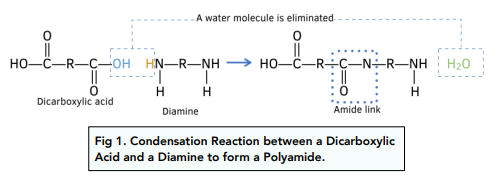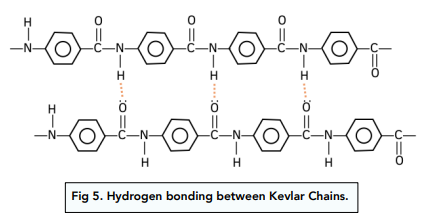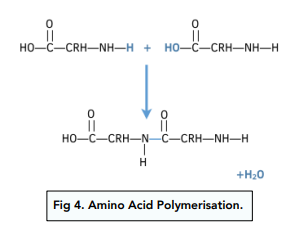Polyamide Formation (A-Level Chemistry)
Polyamide Formation
Condensation Polymers: Polyamides
Polyamides are made when diamine molecules react with dicarboxylic acid molecules.
Diamine molecules have amine groups (R-NH2) at either end of their molecules.
The amine and carboxylic acid groups react to form amide links between the molecules.
Water is removed from the reaction.

Making Nylon 6,6 – a Polyamide
Nylon 6,6 is a polyamide made from 1,6-diaminohexane and hexanedioic acid.

Nylon 6,6 is used to make clothing, rope, carpets, and parachutes.
Making Kevlar: a Polyamide
Kevlar is made by reacting 1,4-diaminobenzene and benzene-1,4- dicarboxylic acid.
Water molecules are removed from the reactants.

Kevlar is used for making bullet-proof vests and car tyres.
Intermolecular Bonds
Polyamides contain an amide link. This consists of N bonded to an H atom, which results in hydrogen bonding between the O of one polymer chain and the H of another as shown in the diagram.

In addition, polyamides also contain permanent dipole-dipole forces.
As hydrogen bonds are stronger than permanent dipole-dipole forces, polyamides have higher melting points than polyesters.
Condensation Polymers: Polypeptides
Polypeptides are made when amino acids polymerise. An amino acid consists of an amine group on one end of the molecule and a carboxylic acid on the other end of the molecule.
Water molecules are given off in the reaction. A peptide bond is formed.

The same amino acid molecule can polymerise to make a polypeptide, or different types of amino acids can join together.
Polypeptides are the building blocks of proteins.
Polyamide Formation is the process of forming a polymer by linking monomers containing amide functional groups. It is an important topic in A-Level Chemistry because it provides an understanding of the structure and reactivity of polymers, which are important materials in many fields, including textiles, plastics, and adhesives.
Polyamides are polymers that contain amide functional groups. They are used in a variety of applications, including textiles, such as nylon, and as structural materials, such as Kevlar. Polyamides are also used in adhesives and coatings, as well as in the production of some types of plastics.
Polyamide Formation is accomplished by the reaction of an amine and a carboxylic acid or its derivative. The reaction results in the formation of an amide bond between the monomers, which then polymerize to form the polyamide.
The steps involved in Polyamide Formation include the reaction of an amine with a carboxylic acid or its derivative, followed by the formation of an amide bond between the monomers. This reaction is typically carried out in the presence of a catalyst and may require the use of solvents or other reagents.
The mechanism of Polyamide Formation involves the reaction of an amine with a carboxylic acid or its derivative to form an amide intermediate. The intermediate then reacts with another molecule of the monomer to form a polymer chain. This process is repeated until a long chain polymer is formed.
The factors that influence Polyamide Formation include the reactivity of the amine and carboxylic acid or its derivative, the presence of a catalyst, the concentration of the monomers, and the reaction conditions, such as temperature and pressure.
Polyamides have a range of properties depending on their structure and composition. They are generally strong, durable, and resistant to wear and tear. They also have a high melting point, which makes them useful in high-temperature applications. In addition, many polyamides are water-resistant and have good chemical resistance.
The advantages of using Polyamides in industrial applications include their strength, durability, and resistance to wear and tear. They are also easy to process and can be molded into a variety of shapes. In addition, many polyamides are resistant to chemicals, water, and high temperatures, which makes them suitable for use in a wide range of applications.
The potential drawbacks of using Polyamides include their high cost, as well as their tendency to absorb moisture, which can affect their properties over time. In addition, some polyamides may be difficult to recycle, which can lead to environmental concerns.





Still got a question? Leave a comment
Leave a comment